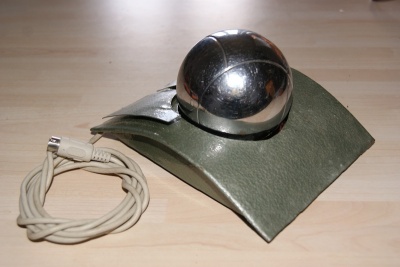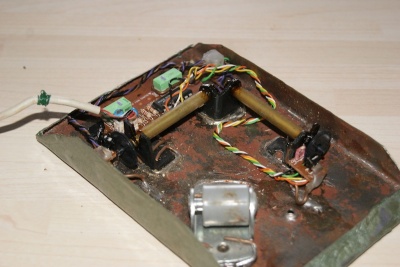Custom Trackball
Posted: 02 Jan 2013, 06:18
So I am working on a DIY trackball. It’s coming along nicely, but I could use some suggestions (see bullets at the end).
I am using a 52.5mm snooker ball because these are a good size, inexpensive, and available in many colors; but it should also work with any hard smooth ball from 50 to 70mm with only minor modification. If you wanted to do something similar, you could use any billiard ball or find some very nice “gemstone” spheres on eBay.
My trackball stand is made from a 2” PVC male adapter, a 2” knockout plug, and a 2” female adapter. I got all three from the local hardware store for under $5 – the first two from plumbing, the third from electrical because it screwed completely onto the male thread where the plumbing female got tight about half way on. I also ordered a package of .125” silicon nitride bearings from eBay.
The first thing I did was to trim the lip of the knockout plug and cut the slip parts of the male and female adapters off. The plug should fit at the bottom of the threads of the female adapter and the two adapters should screw together with the rim of the inner part (male) just capping the outer and the outer part (female and cap) capping the inner. Next, I made a paper template of an equilateral triangle inside a 2” circle to mark the location for three bearings on the top of the male adapter and very carefully drilled about .1” deep with a .125” bit. I inserted the silicon nitride bearings and tested the spin. My Kensington Expert Mouse ball spins better in this stand than in the one made for it. The snooker ball does not spin quite as freely as but still better than many trackballs I have used. The bearing holes are tight enough that the bearings do not fall out even when the stand is inverted. The knockout plug is used as a platform to mount an optical sensor. The optical sensor I have used so far is an Apexone A2637B that I pulled from a cheap USB/PS2 mouse. I had to fit it inside of a 1.9” circle, so I just hacked off the switches and scroll wheel. It fits, but the location of the sensor is not ideal. The knockout plug is placed inside the female adapter and screwed onto the male adapter to the point where the distance to the ball is correct for the optical sensor. This feature should allow the stand to work with a range of ball sizes but you may need to reduce the threaded length and depth of the adapters. It also can be used to lock the trackball into a 2.5” hole on a case that might have L/M/R switches or scroll wheel mounted also. So these are my issues:
• Ideally the sensor “eye” should be at the exact center bottom of the trackball, but due to the size of the lens and PCB that is not possible. I’m thinking of making my own PCB (the mouse chip uses just 3 caps, two resistors, and LED) and using a modified lens (perhaps from a DVD drive). Your thoughts?
• A trackball is a mouse turned upside down, so either the X or Y axis must be flipped on the sensor depending on the way the sensor was turned over. This can be done with an app (SakasaMouse), driver (MAF-Soft Mouse), or mouse firmware. I would like to go firmware, but I don’t think my chip supports it and know I don’t have the skills. Suggestions?
I am using a 52.5mm snooker ball because these are a good size, inexpensive, and available in many colors; but it should also work with any hard smooth ball from 50 to 70mm with only minor modification. If you wanted to do something similar, you could use any billiard ball or find some very nice “gemstone” spheres on eBay.
My trackball stand is made from a 2” PVC male adapter, a 2” knockout plug, and a 2” female adapter. I got all three from the local hardware store for under $5 – the first two from plumbing, the third from electrical because it screwed completely onto the male thread where the plumbing female got tight about half way on. I also ordered a package of .125” silicon nitride bearings from eBay.
The first thing I did was to trim the lip of the knockout plug and cut the slip parts of the male and female adapters off. The plug should fit at the bottom of the threads of the female adapter and the two adapters should screw together with the rim of the inner part (male) just capping the outer and the outer part (female and cap) capping the inner. Next, I made a paper template of an equilateral triangle inside a 2” circle to mark the location for three bearings on the top of the male adapter and very carefully drilled about .1” deep with a .125” bit. I inserted the silicon nitride bearings and tested the spin. My Kensington Expert Mouse ball spins better in this stand than in the one made for it. The snooker ball does not spin quite as freely as but still better than many trackballs I have used. The bearing holes are tight enough that the bearings do not fall out even when the stand is inverted. The knockout plug is used as a platform to mount an optical sensor. The optical sensor I have used so far is an Apexone A2637B that I pulled from a cheap USB/PS2 mouse. I had to fit it inside of a 1.9” circle, so I just hacked off the switches and scroll wheel. It fits, but the location of the sensor is not ideal. The knockout plug is placed inside the female adapter and screwed onto the male adapter to the point where the distance to the ball is correct for the optical sensor. This feature should allow the stand to work with a range of ball sizes but you may need to reduce the threaded length and depth of the adapters. It also can be used to lock the trackball into a 2.5” hole on a case that might have L/M/R switches or scroll wheel mounted also. So these are my issues:
• Ideally the sensor “eye” should be at the exact center bottom of the trackball, but due to the size of the lens and PCB that is not possible. I’m thinking of making my own PCB (the mouse chip uses just 3 caps, two resistors, and LED) and using a modified lens (perhaps from a DVD drive). Your thoughts?
• A trackball is a mouse turned upside down, so either the X or Y axis must be flipped on the sensor depending on the way the sensor was turned over. This can be done with an app (SakasaMouse), driver (MAF-Soft Mouse), or mouse firmware. I would like to go firmware, but I don’t think my chip supports it and know I don’t have the skills. Suggestions?

